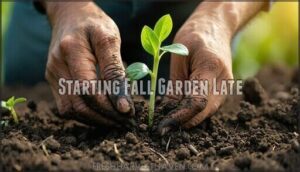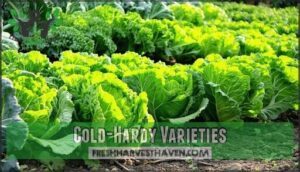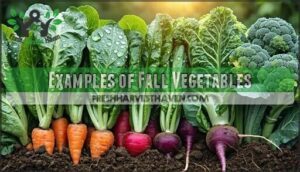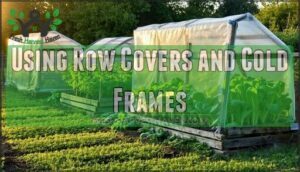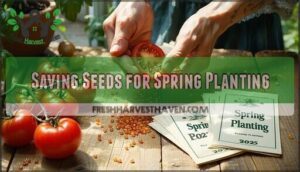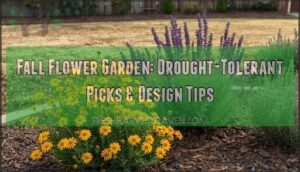This site is supported by our readers. We may earn a commission, at no cost to you, if you purchase through links.
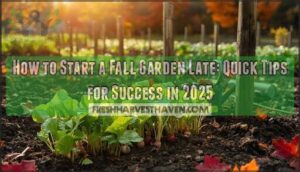 Don’t panic if you’re starting late – you can still grow a productive fall garden.
Don’t panic if you’re starting late – you can still grow a productive fall garden.
Focus on fast-maturing, cold-hardy crops like radishes, lettuce, and spinach that handle cooler weather.
Cool your soil by shading it for a few days and keep it consistently moist to give seeds their best shot at germinating in warm conditions.
Choose varieties specifically bred for shorter growing seasons or labeled as "quick-maturing." Your late start might actually work in your favor since many fall crops prefer the gradually cooling temperatures over sudden heat waves that stressed your summer garden.
Table Of Contents
- Key Takeaways
- Fall Garden Late Start
- Starting Fall Garden Late
- Selecting Fall Crops
- Extending Fall Garden Season
- Frequently Asked Questions (FAQs)
- How late can you plant a fall garden?
- What month is too late to start a garden?
- What is the 3 year rule in gardening?
- Can I plant any vegetables in August?
- When should you plant a garden in the fall?
- How do I plant a fall garden?
- When should you plant fall vegetables?
- Is fall a good time for a garden?
- Can you delay planting a fall garden?
- Is it too late to plant vegetables?
- Conclusion
Key Takeaways
- You can successfully start a fall garden even in late summer by focusing on fast-growing, cold-hardy crops like radishes (30 days), lettuce, and spinach that thrive in cooler temperatures.
- Calculate your planting window by counting backward from your first frost date and adding 2-3 weeks buffer time, then choose varieties with maturity times of 70 days or less.
- Prepare your soil quickly by removing summer debris, adding compost for nutrients, and maintaining consistent moisture in the top quarter-inch to ensure proper seed germination.
- Extend your growing season using row covers and cold frames for frost protection, allowing you to harvest fresh vegetables well into winter months.
Fall Garden Late Start
You can successfully start a fall garden even late in the season by focusing on fast-growing, cold-hardy crops that mature quickly before winter arrives.
Smart fall gardening means choosing crops that race against winter’s clock and actually taste better after a light frost.
The key is choosing vegetables with shorter growing periods and preparing your soil properly to give these resilient plants the best chance to thrive in cooler temperatures.
Planning and Timing
You don’t need to panic if summer slipped away—fall garden planning can still yield great results with smart timing.
Check your first frost date and count backward using each crop’s maturity length, factoring in reduced sunlight impact and temperature preferences for successful experiment planting. Knowing your area’s average first frost is essential for accurate timing.
- Calculate growing days – Subtract maturity length from your first frost date, adding 2-3 weeks buffer for cooler fall temperatures
- Create a fall garden schedule – Prioritize crops under 70 days to maturity and match temperature preferences with current conditions
- Build your fall garden checklist – Focus on cold-hardy varieties that thrive in decreasing sunlight rather than perfect garden conditions
Preparing Soil for Fall
Your fall garden preparation starts with clearing out summer’s leftovers—think of it as giving your soil a fresh slate.
Remove old plant residue and weeds to prevent pest buildup.
Apply compost incorporation and fertilizer application (1-1.5 pounds per 100 square feet) to supercharge soil nutrients. Consider using gardening compost products for ideal soil health.
Keep that top half-inch moist for successful germination through consistent moisture monitoring.
Choosing Right Crops
Smart crop selection makes late fall gardening successful.
Pick fast-growing varieties that thrive in cooler weather for successful late-season harvests.
Choose beginner-friendly crops like lettuce, spinach, and radishes that handle germination temperatures below 70°F.
These cool weather crops mature in 30-45 days, perfect for short season gardening.
Focus on quick growing vegetables that don’t mind changing soil pH levels and reduced crop sunlight needs, which is crucial for successful late fall gardening.
Starting Fall Garden Late
You can successfully start a fall garden even when summer’s winding down by focusing on quick preparation steps that get your soil ready fast.
The key is removing old plant debris, adding compost for nutrients, and keeping the soil consistently moist for seed germination.
Removing Weeds and Debris
Clear away last season’s leftovers before planting your fall crops. Remove dead plants, fallen leaves, and stubborn weeds that compete for nutrients and harbor pests.
Clean tools between garden beds to prevent spreading diseases. Compost healthy debris but dispose of diseased material safely.
Consider using a specialized tool for weeds to make the job easier. This garden cleanup sets the stage for healthy new growth and effective weed control in your refreshed garden beds, ensuring a clean start for fall crops and promoting overall garden health.
Amending Soil With Compost
Rich compost transforms tired garden soil into a nutrient powerhouse for your late-season fall garden.
This decomposition process creates perfect soil structure while delivering essential nutrients your vegetables crave during cooler months. Fall composting can help reduce landfill contributions.
Here’s why compost sources make all the difference:
- Kitchen scraps become black gold – turning everyday waste into nutrient enrichment
- Earthworms work overtime – creating channels that improve drainage and aeration
- Your wallet stays happy – free soil preparation beats expensive fertilizers every time
Maintaining Moisture Levels
How often should you water your late fall garden?
Germination moisture becomes essential as soil drying accelerates in mid-to-late summer heat.
Keep that upper quarter-inch consistently moist—your seeds won’t sprout in dusty dirt!
Check watering frequency daily since fall garden conditions change quickly.
Mulch benefits include retaining precious moisture while you’re busy.
Smart irrigation methods and garden watering strategies make garden maintenance easier for your thriving fall garden, utilizing effective irrigation methods.
Selecting Fall Crops
When you’re starting late, you need crops that can handle cooler weather and mature quickly before winter arrives.
Focus on cold-hardy vegetables with maturity times of 70 days or less, like spinach that’s ready in just 40 days or radishes that’ll surprise you in only 30.
Cold-Hardy Varieties
Frost-tolerant crops like kale and collards become your fall garden’s superheroes, surviving temperatures down to 10°F while actually getting sweeter after frost hits.
Cold-hardy plants such as spinach, carrots, and Brussels sprouts thrive in chilly weather, making late planting possible even when summer crops have long given up the ghost.
For example, consider planting cold-tolerant lettuce varieties like Tango for a late-season harvest.
Shorter Maturity Times
Selecting fast-growing crops becomes your secret weapon for late-season planting success.
These speedy varieties race against shortening daylight hours, delivering fresh harvests before winter arrives.
Quick-Maturity Champions for Fall Gardens:
- 21-35 day crops – Radishes and leaf lettuces for instant gratification
- 30-50 day harvests – Arugula, spinach, and mustard greens with multiple cuttings
- 45-60 day varieties – Bush beans, baby beets, and bok choy for substantial yields
- Temperature adjustment rule – Add 14-28 extra days to maturity dates as fall progresses
Many leafy greens thrive, offering superior culinary qualities compared to store-bought options.
Examples of Fall Vegetables
Your best fall garden vegetables include cold-hardy leafy greens like spinach and kale, quick-growing root vegetables such as radishes and beets, plus sturdy brassicas including broccoli and cabbage.
These autumn vegetables thrive in cooler temperatures and deliver excellent late season harvest results.
| Leafy Greens | Root Vegetables | Brassicas |
|---|---|---|
| Spinach (40 days) | Radishes (28 days) | Broccoli (70 days) |
| Kale (60 days) | Carrots (75 days) | Cabbage (80 days) |
| Arugula (30 days) | Beets (55 days) | Brussels sprouts (90 days) |
| Swiss chard (55 days) | Turnips (50 days) | Kohlrabi (45 days) |
Extending Fall Garden Season
When frost threatens your late fall garden, season extension methods can keep your harvest going strong for months longer.
Smart protection techniques like row covers and cold frames turn chilly autumn weather into productive growing time, letting you enjoy fresh vegetables well into winter.
Using Row Covers and Cold Frames
Row covers and cold frames turn your late-season garden into a productivity powerhouse. These tools create protective microclimates that boost heat retention and deliver essential frost protection for your cold-hardy plants.
Here’s your toolkit for extending growing season success:
- Secure heavyweight row covers with garden staples for 4°F-10°F frost protection
- Build DIY frames from scrap wood and clear plastic for budget-friendly solutions
- Choose breathable fabric material choices that allow rain penetration
- Position cold frames on south-facing slopes for maximum solar gain
- Layer covers strategically without blocking essential sunlight
These season extenders support fall garden vegetables and coldweather crops for months past typical harvest windows. Cold frames, with their transparent lids trap heat.
Providing Protection From Frost
Smart gardeners know that sudden temperature drops can devastate tender plants overnight.
You’ll want frost blanket benefits like trapped warmth around cold weather crops. For added protection, consider investing in specialized plant covers.
Mulch insulation depth of 3-4 inches protects roots while windbreak effectiveness shields plants from energy-sapping gusts.
These greenhouse alternatives keep your fall gardening dreams alive when frost threatens your extending growing season efforts.
Saving Seeds for Spring Planting
Turn your fall harvest into next year’s garden gold by collecting seeds from healthy plants.
Clean tomato and pepper seeds thoroughly, then dry them completely before storing in airtight containers.
Test seed viability in spring by germinating a few samples first, ensuring proper genetic purity intact, and preventing costly garden seed sellout situations, which is crucial for smart garden seed storage.
Frequently Asked Questions (FAQs)
How late can you plant a fall garden?
You can plant fast-growing fall crops like lettuce, spinach, and radishes as late as September, provided they’ll reach 75% maturity before your first frost date arrives.
What month is too late to start a garden?
December typically marks the cutoff for most regions, though you can still plant cold-hardy greens and garlic in many areas through early winter months.
What is the 3 year rule in gardening?
You’ll often hear gardeners mention the "3-year rule", which suggests waiting three years before replanting the same crop family in the same soil location.
This suggestion is made to prevent disease buildup and nutrient depletion.
Can I plant any vegetables in August?
August’s your golden window for fast-growing crops like lettuce, radishes, and spinach.
You’ll beat the heat while these cool-season champions thrive in fall’s approach—just check days to maturity against your frost date.
When should you plant a garden in the fall?
Fall gardening delivers 2-4 extra months of fresh produce when you time it right.
You’ll want to start seeding hardy crops like lettuce, spinach, and radishes in late July through August, giving them enough growing days before your first frost date arrives.
How do I plant a fall garden?
Remove summer plant debris, then apply fertilizer or compost to prepared soil. Plant fast-growing, cold-hardy crops like lettuce, spinach, and radishes that’ll mature before your first frost date arrives.
When should you plant fall vegetables?
You’ll want to plant fall vegetables 60-90 days before your first expected frost date.
Count backward from that date using each crop’s maturity time on seed packets to determine ideal planting windows.
Is fall a good time for a garden?
Like catching a second wind, fall gardening offers you cooler temperatures that reduce pest pressure and watering needs while extending your growing season for fresh produce.
Can you delay planting a fall garden?
Yes, you can delay planting your fall garden, but timing matters.
Fast-growing crops like spinach, arugula, and radishes can handle late September planting if they’ll reach 75% maturity before mid-October’s reduced sunlight.
Is it too late to plant vegetables?
Your gardening dreams aren’t buried yet! It’s not too late to plant fast-growing vegetables like radishes, spinach, and lettuce that’ll mature before frost hits your area.
Conclusion
Like a phoenix rising from summer’s ashes, your late fall garden can flourish with proper care.
Research shows fall crops grown in gradually cooling temperatures often produce sweeter, more tender vegetables than spring plantings.
Remember, learning how to start a fall garden late isn’t about perfect timing—it’s about making the most of what you have.
You’ve got the tools and knowledge now, so grab those seeds and get planting, and your future self will thank you when you’re harvesting fresh greens while others are buying expensive store produce.

